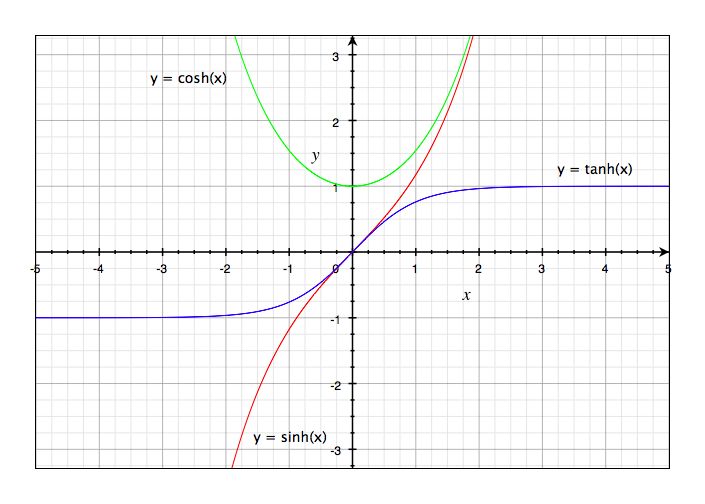Taylor 2.4-2.6 (today) and 2.7-3.1 (Wednesday)
For one-dimensional motion subject to both gravity and quadratic drag, the equation of motion is
where I've chose gravity in the positive direction (y axis pointing downward). When the drag force equals the weight, the net force on the object is zero and it ceases to accelerate or decelerate. This occurs at the terminal velocity
This is the speed that a falling object will eventually obtain, independent of its initial velocity.
Using the terminal velocity, we can rewrite the equation of motion as
and use the technique of separation of variables to obtain
Let's specialize to the case of an object starting from rest, and integrate this expression from 0 to t in t, and from 0 to v in v:
or, solving for v as a function of t
where tanh is the hyperbolic tangent function
and arctanh is the inverse hyperbolic tangent function.

The hyperbolic functions are a set of functions connected to the standard trigonometric fucntions: sin, cos, tan, and their inverses. The hyperbolic sine (sinh), cosine (cosh), and tangent (tanh) functions are graphed above. The hyperbolic tangent appears in a number of situations. It has the properties of tanh(0)=0, d(tanh(z))/dz=1 for z=1, tanh(∞)=+1, tanh(-∞)=-1. The hyperbolic sine and cosine functions are defined as
They have the following properties: sinh(0) = 0, d(sinh(z))/dz = 1 for z=0, sinh(∞) = ∞, sinh(-∞) = -∞, cosh(0) = 1, d(cosh(z)/dz = 0 for z=0, cosh(∞) = cosh(-∞) = ∞. The hyperbolic tangent has the same relation to the hyperbolic sine and cosine functions as tangent has with sine and cosine, that is,
Now back to the discussion of vertical motion with quadratic drag. Integrate to find the postion as a function of time
The equation of motion for a projectile subject to forces of gravity and quadratic drag, moving in two dimensions, is:
Please see read the example of the numerical solution for the motion of a baseball discussed in the text (Example 2.5). Some, hopefully, obvious features are seen. The object's maximum height and range are smaller than in the solution without air resistance. The object reaches it's maximum height sooner then in the vacuum solution. And, maybe not so obviously, there is a maximum distance which the object will move in the horizontal direction, no matter how far it drops vertically (there is a vertical asymptote to the motion). The appearance of a limit to the x motion is surprising, since there was no limit in the case of one-dimensional horizontal motion with quadratic drag.
To see how the limit arises, consider again the equations of motion. If the object has fallen substantially in the vertical direction, then the y velocity will approach the terminal velocity.
A charged particle moving through a magnetic field is subject to the Lorentz force
The equation of motion for a charged particle moving in a uniform magnetic field is
Define ω = qB/m. The quantity ω is known as the cyclotron frequency, for reasons that are explained a little later. We can rewrite the x and y equations with ω as
You should know from introductory physics that the motion in x-y is circular. To demonstrate that this is the case, and demonstrate the technique of change of variables to solve a differential equation, we write a new complex variable
The time derivative of η is